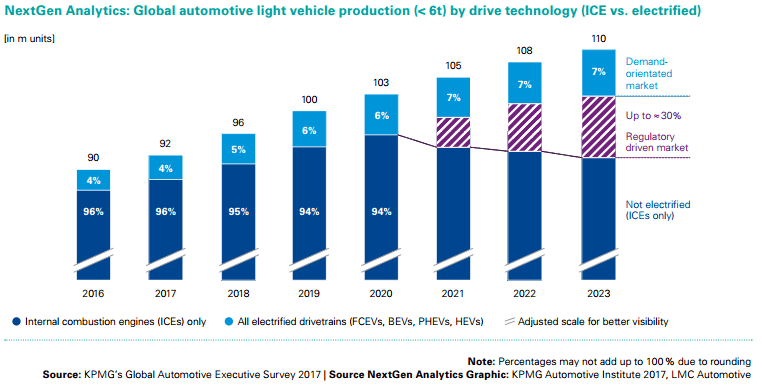Will Electric Vehicle Technology Replace Combustion Soon?

Guided by regulatory requirements and a shift in consumer preferences, electric vehicles are on the path to taking over global market share for new vehicle sales. While there are still many years ahead where internal combustion will reign supreme, the inevitable swing in market preference will eventually catch up. But when will this be? How quickly can electric vehicle technologies improve and take over the market?
Wide-scale adoption of electric vehicles will largely depend on two factors: technology disruptiveness and government regulations. Should technology be developed and adopted quickly, as much as 30-40% of new vehicle sales could be electricity-powered within the next decade.
Automotive manufacturers and technology developers across the world will be looking to develop electric technologies and become part of this market as sales increase. Canadian companies should begin investing in research, development, and integration of electric vehicle (EV) technologies to ensure they can contribute to this market sector and remain globally competitive.
LEARN MORE ABOUT THE TOP 4 TRENDS IN THE CANADIAN AUTOMOTIVE SECTOR
Electric Vehicles: What’s Driving the Market?
Electric vehicle technologies are becoming more powerful and able to drive for longer ranges before needing to be recharged. These elements are two of the most critical quality elements that consumers will use to determine the possibility of switching from a traditional combustion engine to electricity. Consumer preference is still very aligned to combustion, but improving the reliability of EVs will help spur greater consumer interest.
The global EV market will also be driven by changes to government legislation. Countries realize the important role they will play in reducing carbon emissions and preventing climate change; this could impact new vehicle sales greatly. KPMG’s 2017 Global Automotive Executive Survey indicated that up to 30% of the global market could be driven by regulations where customers are incentivized to buy electric vehicles.

Together, increased consumer interest and the regulatory market will create demand for new electric vehicle technology. Automotive manufacturers should look for ways to serve this market since it is already viable and will become increasingly lucrative in coming years.
Technology Disruption Rates
The rate at which electric vehicle technologies will be adopted is still speculative. In high-disruption scenarios (where EVs are adopted quickly and enthusiastically by the market), EVs could gain widespread acceptance in just a few years. In low-disruption scenarios, it could still be decades before EVs are on the roads in vast numbers.
The rate of electric vehicle technology disruption will depend on a few factors:
- Regulatory Challenges
- Safety and Technical Viability
- Consumer Acceptance and Willingness to Pay
Types of Electric Vehicles Being Adopted
While electric vehicles may be the way of the future, automotive manufacturers must prepare to help customers transition. To do this, a range of engines will be needed; this will help bring a sense of security and control to new car owners. Some of the many fuel/engine types available include:
- Full Hybrid Electric Vehicles (FHEV): Full (traditional) hybrids contain both a gasoline and combustion engine to extend range and fuel efficiency. Batteries are not recharged by plugging-in the vehicle though; rather, regenerative systems in the vehicle return energy to batteries and charge the electrical power source when the vehicle is in motion.
- Plugin Hybrid Electric Vehicles (PHEV): Contain both an electric motor and internal combustion engine; electric battery technology can be charged from traditional power outlets.
- Battery Electric Vehicles (BEV): Contains only an electric motor, but generally has a longer range than PHEVs. These can be charged either through an outlet or charging station.
- Fuel Cell Electric Vehicles (FCEV): Contains an electric motor that is powered by hydrogen gas and oxygen; combined, these fuel sources power the vehicle and create water as a by-product. There is no recharging of batteries, so the vehicle would need to refuel at a filling station.
Opportunities for Automotive Technology Investments
For automotive manufacturers to remain competitive in shifting markets, investing in electric vehicle technologies is critical. Providing products and services for EVs will help generate new revenue streams and transition to an increasingly EV-dominant market.
There are incredible opportunities existing in the space to improve current EV technologies, including:
- Battery life/vehicle range;
- Charging technologies;
- Reducing battery size or weight; and
- Regenerative energy technologies.
Government grants for manufacturers are also available to help reduce the cost of investments. Discover automotive government grants and repayable funding to offset a portion of your overall technology investment costs.
Top 4 Trends in The Canadian Automotive Sector
Electric vehicle technologies are just one of the major trends impacting the Canadian automotive sector. Automotive manufacturers can learn more about the emergence of EVs, in addition to the other three trends, by downloading Mentor Works’ Top 4 Trends in The Canadian Automotive Sector white paper.

